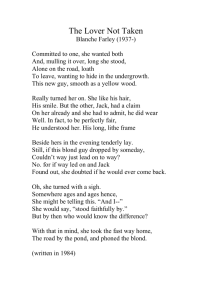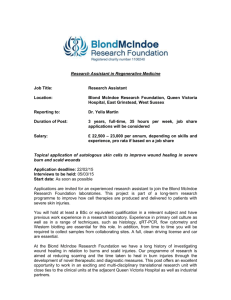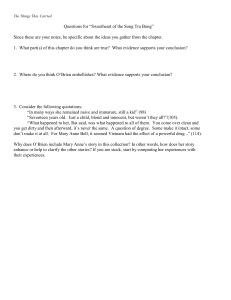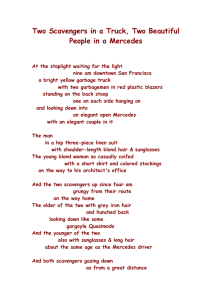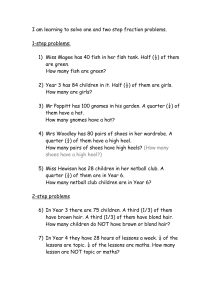Course 395: Machine Learning
advertisement
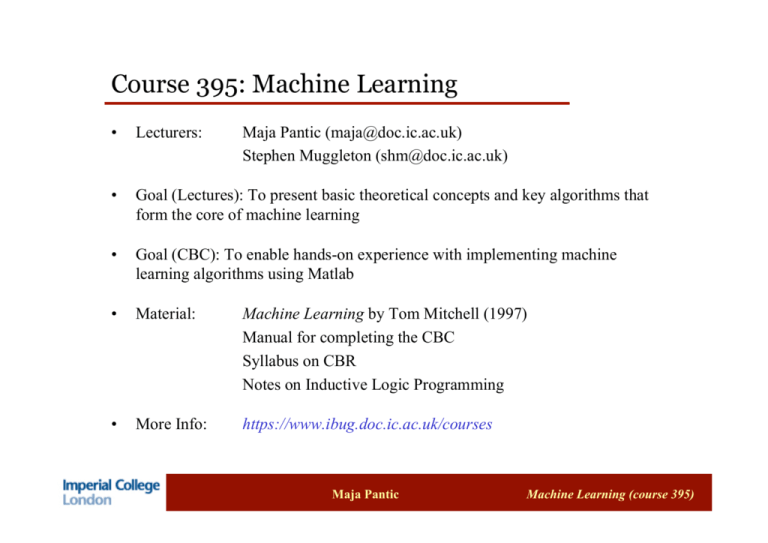
Course 395: Machine Learning
•
Lecturers:
Maja Pantic (maja@doc.ic.ac.uk)
Stephen Muggleton (shm@doc.ic.ac.uk)
•
Goal (Lectures): To present basic theoretical concepts and key algorithms that
form the core of machine learning
•
Goal (CBC): To enable hands-on experience with implementing machine
learning algorithms using Matlab
•
Material:
Machine Learning by Tom Mitchell (1997)
Manual for completing the CBC
Syllabus on CBR
Notes on Inductive Logic Programming
•
More Info:
https://www.ibug.doc.ic.ac.uk/courses
Maja Pantic
Machine Learning (course 395)
Course 395: Machine Learning – Lectures
• Lecture 1-2: Concept Learning (M. Pantic)
• Lecture 3-4: Decision Trees & CBC Intro (M. Pantic)
• Lecture 5-6: Artificial Neural Networks (THs)
• Lecture 7-8: Instance Based Learning (M. Pantic)
• Lecture 9-10: Genetic Algorithms (M. Pantic)
• Lecture 11-12: Evaluating Hypotheses (THs)
• Lecture 13-14: Guest Lectures on ML Applications
• Lecture 15-16: Inductive Logic Programming (S. Muggleton)
• Lecture 17-18: Inductive Logic Programming (S. Muggleton)
Maja Pantic
Machine Learning (course 395)
Course 395: Machine Learning – Exam Material
• Lecture 1-2: Concept Learning (Mitchell: Ch.1, Ch.2)
• Lecture 3-4: Decision Trees & CBC Intro (Mitchell: Ch.3)
• Lecture 5-6: Artificial Neural Networks (Mitchell: Ch.4)
• Lecture 7-8: Instance Based Learning (Syllabus, Mitchell: Ch.8)
• Lecture 9-10: Genetic Algorithms (Mitchell: Ch.9)
• Lecture 11-12: Evaluating Hypotheses (Mitchell: Ch.5)
• Lecture 13-14: not examinable
• Lecture 15-16: Inductive Logic Programming (Notes)
• Lecture 17-18: Inductive Logic Programming (Notes)
Maja Pantic
Machine Learning (course 395)
Course 395: Machine Learning - CBC
• Lecture 1-2: Concept Learning
• Lecture 3-4: Decision Trees & CBC Intro
• Lecture 5-6: Artificial Neural Networks
• Lecture 7-8: Instance Based Learning
• Lecture 9-10: Genetic Algorithms
• Lecture 11-12: Evaluating Hypotheses
• Lecture 13-14: Guest Lectures on ML Applications
• Lecture 15-16: Inductive Logic Programming
• Lecture 17-18: Inductive Logic Programming
Maja Pantic
Machine Learning (course 395)
Course 395: Machine Learning
NOTE
CBC accounts for 33% of the final grade for the Machine Learning Exam.
final grade = 0.66*exam_grade + 0.33*CBC_grade
Maja Pantic
Machine Learning (course 395)
Course 395: Machine Learning - CBC
• Lecture 1-2: Concept Learning
• Lecture 3-4: Decision Trees & CBC Intro
• Lecture 5-6: Artificial Neural Networks
• Lecture 7-8: Instance Based Learning
• Lecture 9-10: Genetic Algorithms
• Lecture 11-12: Evaluating Hypotheses
• Lecture 13-14: Guest Lectures on ML Applications
• Lecture 15-16: Inductive Logic Programming
• Lecture 17-18: Inductive Logic Programming
Maja Pantic
Machine Learning (course 395)
Course 395: Machine Learning – Lectures
• Lecture 1-2: Concept Learning (M. Pantic)
• Lecture 3-4: Decision Trees & CBC Intro (M. Pantic)
• Lecture 5-6: Artificial Neural Networks (THs)
• Lecture 7-8: Instance Based Learning (M. Pantic)
• Lecture 9-10: Genetic Algorithms (M. Pantic)
• Lecture 11-12: Evaluating Hypotheses (THs)
• Lecture 13-14: Guest Lectures on ML Applications
• Lecture 15-16: Inductive Logic Programming (S. Muggleton)
• Lecture 17-18: Inductive Logic Programming (S. Muggleton)
Maja Pantic
Machine Learning (course 395)
Concept Learning – Lecture Overview
• Why machine learning?
• Well-posed learning problems
• Designing a machine learning system
• Concept learning task
• Concept learning as Search
• Find-S algorithm
• Candidate-Elimination algorithm
Maja Pantic
Machine Learning (course 395)
Machine Learning
• Learning ↔ Intelligence
(Def: Intelligence is the ability to learn and use concepts to solve problems.)
• Machine Learning ↔ Artificial Intelligence
– Def: AI is the science of making machines do things that require
intelligence if done by men (Minsky 1986)
– Def: Machine Learning is an area of AI concerned with development of
techniques which allow machines to learn
• Why Machine Learning? ↔ Why Artificial Intelligence?
Maja Pantic
Machine Learning (course 395)
Machine Learning
Maja Pantic
Machine Learning (course 395)
Machine Learning
• Learning ↔ Intelligence
(Def: Intelligence is the ability to learn and use concepts to solve problems.)
• Machine Learning ↔ Artificial Intelligence
– Def: AI is the science of making machines do things that require
intelligence if done by men (Minsky 1986)
– Def: Machine Learning is an area of AI concerned with development of
techniques which allow machines to learn
• Why Machine Learning? ↔ Why Artificial Intelligence?
≡ To build machines exhibiting intelligent behaviour (i.e., able to reason,
predict, and adapt) while helping humans work, study, and entertain
themselves
Maja Pantic
Machine Learning (course 395)
Machine Learning
• Machine Learning ↔ Artificial Intelligence
• Machine Learning ← Biology (e.g., Neural Networks, Genetic Algorithms)
• Machine Learning ← Cognitive Sciences (e.g., Case-based Reasoning)
• Machine Learning ← Statistics (e.g., Support Vector Machines)
• Machine Learning ← Probability Theory (e.g., Bayesian Networks)
• Machine Learning ← Logic (e.g., Inductive Logic Programming)
• Machine Learning ← Information Theory (e.g., used by Decision Trees)
Maja Pantic
Machine Learning (course 395)
Machine Learning
•
Human Learning ↔ Machine Learning
– human-logic inspired problem solvers (e.g., rule-based reasoning)
– biologically inspired problem solvers (e.g., Neural Networks)
• supervised learning - generates a function that maps inputs to desired outputs
• unsupervised learning - models a set of inputs, labelled examples are not available
– learning by education (e.g., reinforcement learning, case-based reasoning)
•
General Problem Solvers vs. Purposeful Problem Solvers
– emulating general-purpose human-like problem solving is impractical
– restricting the problem domain results in ‘rational’ problem solving
– example of General Problem Solver: Turing Test
– examples of Purposeful Problem Solvers: speech recognisers, face recognisers,
facial expression recognisers, data mining, games, etc.
•
Application domains: security, medicine, education, finances, genetics, etc.
Maja Pantic
Machine Learning (course 395)
Well-posed Learning Problems
• Def 1 (Mitchell 1997):
A computer program is said to learn from experience E with respect to some
class of tasks T and performance measure P, if its performance at tasks in T,
as measured by P, improves by experience E.
• Def 2 (Hadamard 1902):
A (machine learning) problem is well-posed if a solution to it exists, if that
solution is unique, and if that solution depends on the data / experience but it
is not sensitive to (reasonably small) changes in the data / experience.
Maja Pantic
Machine Learning (course 395)
Designing a Machine Learning System
•
Target Function V represents the problem to be solved
(e.g., choosing the best next move in chess, identifying people,
classifying facial expressions into emotion categories)
•
V: D → C where D is the input state space and C is the set of classes
V: D → [-1, 1] is a general target function of a binary classifier
•
Ideal Target Function is usually not known; machine learning
algorithms learn an approximation of V, say V’
•
Representation of function V’ to be learned should
– be as close an approximation of V as possible
– require (reasonably) small amount of training data to be learned
•
V’(d) = w0 + w1x1 +…+ wnxn where ‹x1…xn› ≡ d ∈ D is an input state.
This reduces the problem to learning (the most optimal) weights w.
Well-posed
Problem?
Determine type of
training examples
Determine
Target Function
Choose Target F-on
Representation
Choose Learning
Algorithm
Maja Pantic
Machine Learning (course 395)
Designing a Machine Learning System
•
V: D → C where D is the input state and C is the set of classes
V: D → [-1, 1] is a general target function of a binary classifier
Well-posed
Problem?
•
V’(d) = w0 + w1x1 +…+ wnxn where ‹x1…xn› ≡ d ∈ D is an input state.
This reduces the problem to learning (the most optimal) weights w.
Determine type of
training examples
•
Training examples suitable for the given target function representation
V’ are pairs ‹d, c› where c ∈ C is the desired output (classification) of
the input state d ∈ D.
•
Learning algorithm learns the most optimal set of weights w (so-called
best hypothesis), i.e., the set of weights that best fit the training
examples ‹d, c›.
•
Learning algorithm is selected based on the availability of training
examples (supervised vs. unsupervised), knowledge of the final set of
classes C (offline vs. online, i.e., eager vs. lazy), availability of a tutor
(reinforcement learning).
•
The learned V’ is then used to solve new instances of the problem.
Determine
Target Function
Choose Target F-on
Representation
Choose Learning
Algorithm
Maja Pantic
Machine Learning (course 395)
Concept Learning
• Concept learning
– supervised, eager learning
– target problem: whether something belongs to the target concept or not
– target function: V: D → {true, false}
• Underlying idea: Humans acquire general concepts from specific examples
(e.g., concepts: living organism, beauty, computer, well-fitting-shoes)
(note: each concept can be thought of as Boolean-valued function)
• Concept learning is inferring a Boolean-valued function from training data
→ concept learning is the prototype binary classification
Maja Pantic
Machine Learning (course 395)
Concept Learning Task – An Example
•
Concept learning task:
– target concept: Girls who Simon likes
– target function: c: D → {0, 1}
– data d ∈ D: Girls, each described in terms of the following attributes
•
•
•
•
•
•
a1 ≡ Hair (possible values: blond, brown, black)
a2 ≡ Body (possible values: thin, normal, plump)
a3 ≡ likesSimon (possible values: yes, no)
a4 ≡ Pose (possible values: arrogant, natural, goofy)
a5 ≡ Smile (possible values: none, pleasant, toothy)
a6 ≡ Smart (possible values: yes, no)
– target f-on representation: h ≡ c’: ‹a1, a2, a3, a4, a5, a6› → {0, 1}
– training examples D: positive and negative examples of target function c
•
Aim: Find a hypothesis h∈ H such that (∀d ∈ D) h(d) – c(d) < ε ≈ 0, where H is the
set of all possible hypotheses h ≡ ‹a1, a2, a3, a4, a5, a6›, where each ak, k = [1..6], may
be ‘?’ (≡ any value is acceptable), ‘0’ (≡ no value is acceptable), or a specific value.
Maja Pantic
Machine Learning (course 395)
Concept Learning Task – Notation
•
Concept learning task:
– target concept: Girls who Simon likes
– target function: c: D → {0, 1}
– data d ∈ D: Girls, each described in terms of the following attributes
•
•
instances •
•
•
•
a1 ≡ Hair (possible values: blond, brown, black)
a2 ≡ Body (possible values: thin, normal, plump)
a3 ≡ likesSimon (possible values: yes, no)
a4 ≡ Pose (possible values: arrogant, natural, goofy)
a5 ≡ Smile (possible values: none, pleasant, toothy)
a6 ≡ Smart (possible values: yes, no)
error rate
– target f-on representation: h ≡ c’: ‹a1, a2, a3, a4, a5, a6› → {0, 1}
– training examples D: positive and negative examples of target function c
•
Aim: Find a hypothesis h∈ H such that (∀d ∈ D) h(d) – c(d) < ε ≈ 0, where H is the
set of all possible hypotheses h ≡ ‹a1, a2, a3, a4, a5, a6›, where each ak, k = [1..6], may
be ‘?’ (≡ any value is acceptable), ‘0’ (≡ no value is acceptable), or a specific value.
h ≡ ‹?, ?, ?, ?, ?, ?›
h ≡ ‹0, 0, 0, 0, 0, 0›
Maja Pantic
h ≡ ‹?, ?, yes, ?, ?, ?›
Machine Learning (course 395)
Concept Learning as Search
•
Concept learning task:
– target concept: Girls who Simon likes
– target function: c: D → {0, 1}
– data d ∈ D: Girls, each described in terms of the following attributes
•
•
instances •
•
•
•
a1 ≡ Hair (possible values: blond, brown, black)
+‘?’
a2 ≡ Body (possible values: thin, normal, plump)
a3 ≡ likesSimon (possible values: yes, no) +‘?’ |H| = 1 + 4· 4· 3· 4· 4· 3 = 2305
a4 ≡ Pose (possible values: arrogant, natural, goofy)
a5 ≡ Smile (possible values: none, pleasant, toothy) +‘?’
h ≡‹0,0,0,0,0,0›
error rate
+‘?’
a6 ≡ Smart (possible values: yes, no)
– target f-on representation: h ≡ c’: ‹a1, a2, a3, a4, a5, a6› → {0, 1}
– training examples D: positive and negative examples of target function c
•
Aim: Find a hypothesis h∈ H such that (∀d ∈ D) h(d) – c(d) < ε ≈ 0, where H is the
set of all possible hypotheses h ≡ ‹a1, a2, a3, a4, a5, a6›, where each ak, k = [1..6], may
be ‘?’ (≡ any value is acceptable), ‘0’ (≡ no value is acceptable), or a specific value.
concept learning ≡ searching through H
Maja Pantic
Machine Learning (course 395)
General-to-Specific Ordering
•
Many concept learning algorithms utilize general-to-specific ordering of hypotheses
•
General-to-Specific Ordering:
– h1 precedes (is more general than) h2 ⇔ (∀d ∈ D) (h1(d) = 1) ← (h2(d) = 1)
(e.g., h1 ≡ ‹?, ?, yes,?, ?, ?› and h2 ≡ ‹?, ?, yes,?, ?, yes› ⇒ h1 >g h2 )
– h1 and h2 are of equal generality ⇔
(∃d ∈ D) { [(h1(d) = 1) → (h2(d) = 1)] ∧ [(h2(d) = 1) → (h1(d) = 1)] }
(e.g., h1 ≡ ‹?, ?, yes,?, ?, ?› and h2 ≡ ‹?, ?, ?, ?, ?, yes› ⇒ h1 =g h2 )
– h2 succeeds (is more specific than) h1 ⇔ (∀d ∈ D) (h1(d) = 1) ← (h2(d) = 1)
(e.g., h1 ≡ ‹?, ?, yes,?, ?, ?› and h2 ≡ ‹?, ?, yes,?, ?, yes› ⇒ h2 ≥g h1 )
Maja Pantic
Machine Learning (course 395)
Find-S Algorithm
1. Initialise h∈ H to the most specific hypothesis: h ← ‹a1,…,an›, (∀i) ai = 0.
2. FOR each positive training instance d ∈ D, do:
FOR each attribute ai, i = [1..n], in h, do:
IF ai is satisfied by d
THEN do nothing
ELSE replace ai in h so that the resulting h’ >g h, h ← h’.
3. Output hypothesis h.
Maja Pantic
Machine Learning (course 395)
Find-S Algorithm – Example
1. Initialise h∈ H to the most specific hypothesis: h ← ‹a1,…,an›, (∀i) ai = 0.
2. FOR each positive training instance d ∈ D, do:
FOR each attribute ai, i = [1..n], in h, do:
IF ai is satisfied by d
THEN do nothing
ELSE replace ai in h so that the resulting h’ >g h, h ← h’.
3. Output hypothesis h.
c(d)
hair
body
likesSimon
pose
smile
smart
1
1
blond
thin
yes
arrogant
toothy
no
2
0
brown
thin
no
natural
pleasant
yes
3
1
blond
plump
yes
goofy
pleasant
no
4
0
black
thin
no
arrogant
none
no
5
0
blond
plump
no
natural
toothy
yes
h ← ‹0,0,0,0,0,0›
→
h ≡ d1
→
h ← ‹blond, ?, yes, ?, ?, no›
Maja Pantic
Machine Learning (course 395)
Find-S Algorithm
•
•
•
Find-S is guaranteed to output the most specific hypothesis h that best fits positive
training examples.
The hypothesis h returned by Find-S will also fit negative examples as long as
training examples are correct.
However,
– Find-S is sensitive to noise that is (almost always) present in training examples.
– there is no guarantee that h returned by Find-S is the only h that fits the data.
– several maximally specific hypotheses may exist that fits the data but, Find-S
will output only one.
– Why we should prefer most specific hypotheses over, e.g., most general
hypotheses?
Maja Pantic
Machine Learning (course 395)
Find-S Algorithm – Example
1. Initialise h∈ H to the most specific hypothesis: h ← ‹a1,…,an›, (∀i) ai = 0.
2. FOR each positive training instance d ∈ D, do:
FOR each attribute ai, i = [1..n], in h, do:
IF ai is satisfied by d
THEN do nothing
ELSE replace ai in h so that the resulting h’ >g h, h ← h’.
3. Output hypothesis h.
c(d)
hair
body
likesSimon
pose
smile
smart
1
1
blond
thin
yes
arrogant
toothy
no
2
0
brown
thin
no
natural
pleasant
yes
3
1
blond
plump
yes
goofy
pleasant
no
4
0
black
thin
no
arrogant
none
no
5
0
blond
plump
no
natural
toothy
yes
Find-S → h = ‹blond, ?, yes, ?, ?, no› BUT h2 = ‹blond,?, ?, ?, ?, no> fits D as well
Maja Pantic
Machine Learning (course 395)
Find-S Algorithm
•
•
•
Find-S is guaranteed to output the most specific hypothesis h that best fits positive
training examples.
The hypothesis h returned by Find-S will also fit negative examples as long as
training examples are correct.
However,
– Find-S is sensitive to noise that is (almost always) present in training examples.
– there is no guarantee that h returned by Find-S is the only h that fits the data.
– several maximally specific hypotheses may exist that fits the data but, Find-S
will output only one.
– Why we should prefer most specific hypotheses over, e.g., most general
hypotheses?
Maja Pantic
Machine Learning (course 395)
Find-S Algorithm – Example
1. Initialise h∈ H to the most specific hypothesis: h ← ‹a1,…,an›, (∀i) ai = 0.
2. FOR each positive training instance d ∈ D, do:
FOR each attribute ai, i = [1..n], in h, do:
IF ai is satisfied by d
THEN do nothing
ELSE replace ai in h so that the resulting h’ >g h, h ← h’.
3. Output hypothesis h.
c(d)
hair
body
likesSimon
pose
smile
smart
1
1
blond
thin
yes
arrogant
toothy
no
2
0
brown
thin
no
natural
pleasant
yes
3
1
blond
plump
yes
goofy
pleasant
no
4
0
black
thin
no
arrogant
none
no
5
0
blond
plump
no
natural
toothy
yes
Find-S → h1 = ‹blond, ?, ?, ?, ?, no› YET h2 = ‹blond,?, yes, ?, ?, ?> fits D as well
Maja Pantic
Machine Learning (course 395)
Find-S Algorithm
•
•
•
Find-S is guaranteed to output the most specific hypothesis h that best fits positive
training examples.
The hypothesis h returned by Find-S will also fit negative examples as long as
training examples are correct.
However,
1. Find-S is sensitive to noise that is (almost always) present in training examples.
2. there is no guarantee that h returned by Find-S is the only h that fits the data.
3. several maximally specific hypotheses may exist that fits the data but, Find-S
will output only one.
4. Why we should prefer most specific hypotheses over, e.g., most general
hypotheses?
Maja Pantic
Machine Learning (course 395)
Candidate-Elimination Algorithm
•
•
•
Find-S is guaranteed to output the most specific hypothesis h that best fits positive
training examples.
The hypothesis h returned by Find-S will also fit negative examples as long as
training examples are correct.
However,
1. Find-S is sensitive to noise that is (almost always) present in training examples.
2. there is no guarantee that h returned by Find-S is the only h that fits the data.
3. several maximally specific hypotheses may exist that fits the data but, Find-S
will output only one.
4. Why we should prefer most specific hypotheses over, e.g., most general
hypotheses?
To address the last three drawbacks of Find-S, Candidate-Elimination was proposed
Maja Pantic
Machine Learning (course 395)
Candidate-Elimination (C-E) Algorithm
•
Main idea: Output a set of hypothesis VS ⊆ H that fit (are consistent) with data D
•
Candidate-Elimination (C-E) Algorithm is based upon:
– general-to-specific ordering of hypotheses
– Def: h is consistent (fits) data D ⇔ (∀‹d, c(d)›) h(d) = c(d)
– Def: version space VS ⊆ H is set of all h ∈ H that are consistent with D
•
C-E algorithm defines VS in terms of two boundaries:
– general boundary G ⊆ VS is a set of all h ∈ VS that are the most general
– specific boundary S ⊆ VS is a set of all h ∈ VS that are the most specific
Maja Pantic
Machine Learning (course 395)
Candidate-Elimination (C-E) Algorithm
1. Initialise G∈ VS to the most general hypothesis: h ← ‹a1,…,an›, (∀i) ai = ?.
Initialise S∈ VS to the most specific hypothesis: h ← ‹a1,…,an›, (∀i) ai = 0.
2. FOR each training instance d ∈ D, do:
IF d is a positive example
Remove from G all h that are not consistent with d.
FOR each hypothesis s ∈ S that is not consistent with d, do:
- replace s with all h that are consistent with d, h >g s, h ≥g g ∈ G,
- remove from S all s being more general than other s in S.
IF d is a negative example
Remove from S all h that are not consistent with d.
FOR each hypothesis g ∈ G that is not consistent with d, do:
- replace g with all h that are consistent with d, g >g h, h >g s ∈ S,
- remove from G all g being less general than other g in G.
3. Output hypothesis G and S.
Maja Pantic
Machine Learning (course 395)
C-E Algorithm – Example
c(d)
hair
body
likesSimon
pose
smile
smart
1
1
blond
thin
yes
arrogant
toothy
no
2
0
brown
thin
no
natural
pleasant
yes
3
1
blond
plump
yes
goofy
pleasant
no
4
0
black
thin
no
arrogant
none
no
5
0
blond
plump
no
natural
toothy
yes
G0 ← {‹?, ?, ?, ?, ?, ?›} , S0 ← {‹0, 0, 0, 0, 0, 0›}
Maja Pantic
Machine Learning (course 395)
C-E Algorithm – Example
c(d)
hair
body
likesSimon
pose
smile
smart
1
1
blond
thin
yes
arrogant
toothy
no
2
0
brown
thin
no
natural
pleasant
yes
3
1
blond
plump
yes
goofy
pleasant
no
4
0
black
thin
no
arrogant
none
no
5
0
blond
plump
no
natural
toothy
yes
d1 is positive → refine S
no g ∈ G0 is inconsistent with d1 →
G1 ← G0 ≡ {‹?, ?, ?, ?, ?, ?›}
add to S all minimal generalizations of s∈ S0 such that s∈ S1 is consistent with d1
S1 ← {‹blond, thin, yes, arrogant, toothy, no›}
Maja Pantic
Machine Learning (course 395)
C-E Algorithm – Example
c(d)
hair
body
likesSimon
pose
smile
smart
1
1
blond
thin
yes
arrogant
toothy
no
2
0
brown
thin
no
natural
pleasant
yes
3
1
blond
plump
yes
goofy
pleasant
no
4
0
black
thin
no
arrogant
none
no
5
0
blond
plump
no
natural
toothy
yes
d2 is negative → refine G
no s ∈ S1 is inconsistent with d2 →
S2 ← S1 ≡ {‹blond, thin, yes, arrogant, toothy, no›}
add to G all minimal specializations of g∈ G1 such that g∈ G2 is consistent with d2
G1 ≡ {‹?, ?, ?, ?, ?, ?›}
G2 ← {‹blond, ?, ?, ?, ?, ?› , ‹?, ?, yes, ?, ?, ?› , ‹?, ?, ?, arrogant, ?, ?› ,
‹?, ?, ?, ?, toothy, ?›, ‹?, ?, ?, ?, ?, no› }
Maja Pantic
Machine Learning (course 395)
C-E Algorithm – Example
c(d)
hair
body
likesSimon
pose
smile
smart
1
1
blond
thin
yes
arrogant
toothy
no
2
0
brown
thin
no
natural
pleasant
yes
3
1
blond
plump
yes
goofy
pleasant
no
4
0
black
thin
no
arrogant
none
no
5
0
blond
plump
no
natural
toothy
yes
d3 is positive → refine S
two g∈ G2 are inconsistent with d3, i.e., ‹?, ?, ?, arrogant, ?, ?› and ‹?, ?, ?, ?, toothy, ?› →
G3 ← {‹blond, ?, ?, ?, ?, ?› , ‹?, ?, yes, ?, ?, ?› , ‹?, ?, ?, ?, ?, no› }
add to S all minimal generalizations of s∈ S2 such that s∈ S3 is consistent with d3
S2 ≡ {‹blond, thin, yes, arrogant, toothy, no›}
S3 ← {‹blond, ?, yes, ?, ?, no›}
Maja Pantic
Machine Learning (course 395)
C-E Algorithm – Example
c(d)
hair
body
likesSimon
pose
smile
smart
1
1
blond
thin
yes
arrogant
toothy
no
2
0
brown
thin
no
natural
pleasant
yes
3
1
blond
plump
yes
goofy
pleasant
no
4
0
black
thin
no
arrogant
none
no
5
0
blond
plump
no
natural
toothy
yes
d4 is negative → refine G
no s ∈ S3 is inconsistent with d4 →
S4 ← S3 ≡ {‹blond, ?, yes, ?, ?, no›}
add to G all minimal specializations of g∈ G3 such that g∈ G4 is consistent with d4
G3 ≡ {‹blond, ?, ?, ?, ?, ?› , ‹?, ?, yes, ?, ?, ?› , ‹?, ?, ?, ?, ?, no› }
G4 ← {‹blond, ?, ?, ?, ?, ?› , ‹?, ?, yes, ?, ?, ?› }
Maja Pantic
Machine Learning (course 395)
C-E Algorithm – Example
c(d)
hair
body
likesSimon
pose
smile
smart
1
1
blond
thin
yes
arrogant
toothy
no
2
0
brown
thin
no
natural
pleasant
yes
3
1
blond
plump
yes
goofy
pleasant
no
4
0
black
thin
no
arrogant
none
no
5
0
blond
plump
no
natural
toothy
yes
d5 is negative → refine G
no s ∈ S4 is inconsistent with d4 →
S5 ← S4 ≡ {‹blond, ?, yes, ?, ?, no›}
add to G all minimal specializations of g∈ G4 such that g∈ G5 is consistent with d5
G4 ≡ {‹blond, ?, ?, ?, ?, ?› , ‹?, ?, yes, ?, ?, ?›}
G5 ← {‹blond, ?, ?, ?, ?, no› , ‹?, ?, yes, ?, ?, ?› }
"
Maja Pantic
Machine Learning (course 395)
C-E Algorithm – Example
c(d)
hair
body
likesSimon
pose
smile
smart
1
1
blond
thin
yes
arrogant
toothy
no
2
0
brown
thin
no
natural
pleasant
yes
3
1
blond
plump
yes
goofy
pleasant
no
4
0
black
thin
no
arrogant
none
no
5
0
blond
plump
no
natural
toothy
yes
Output of C-E:
version space of hypotheses VS ⊆ H bound with
specific boundary S ≡ {‹blond, ?, yes, ?, ?, no›} and
general boundary G ≡ {‹?, ?, yes, ?, ?, ?› }
Output of Find-S:
most specific hypothesis h ≡ ‹blond, ?, yes, ?, ?, no›
Maja Pantic
Machine Learning (course 395)
C-E Algorithm – Example
c(d)
hair
body
likesSimon
pose
smile
smart
1
1
blond
thin
yes
arrogant
toothy
no
2
0
brown
thin
no
natural
pleasant
yes
3
1
blond
plump
yes
goofy
pleasant
no
4
0
black
thin
no
arrogant
none
no
5
0
blond
plump
no
natural
toothy
yes
Output of C-E:
version space of hypotheses VS ⊆ H bound with
specific boundary S ≡ {‹blond, ?, yes, ?, ?, no›} and
general boundary G ≡ {‹?, ?, yes, ?, ?, ?› }
VS ≡ {‹?, ?, yes, ?, ?, ?› , ‹blond, ?, yes, ?, ?, ?› ,
‹?, ?, yes, ?, ?, no› , ‹blond, ?, yes, ?, ?, no›}
Maja Pantic
Machine Learning (course 395)
Concept Learning – Lecture Overview
• Why machine learning?
• Well-posed learning problems
• Designing a machine learning system
• Concept learning task
• Concept learning as Search
• Find-S algorithm
• Candidate-Elimination algorithm
Maja Pantic
Machine Learning (course 395)
Concept Learning – Exam Questions
• Tom Mitchell’s book – chapter 1 and chapter 2
• Relevant exercises from chapter 1: 1.1, 1.2, 1.3, 1.5
• Relevant exercises from chapter 2: 2.1, 2.2, 2.3, 2.4, 2.5
Maja Pantic
Machine Learning (course 395)
Course 395: Machine Learning – Lectures
• Lecture 1-2: Concept Learning (M. Pantic)
• Lecture 3-4: Decision Trees & CBC Intro (M. Pantic)
• Lecture 5-6: Artificial Neural Networks (THs)
• Lecture 7-8: Instance Based Learning (M. Pantic)
• Lecture 9-10: Genetic Algorithms (M. Pantic)
• Lecture 11-12: Evaluating Hypotheses (THs)
• Lecture 13-14: Guest Lectures on ML Applications
• Lecture 15-16: Inductive Logic Programming (S. Muggleton)
• Lecture 17-18: Inductive Logic Programming (S. Muggleton)
Maja Pantic
Machine Learning (course 395)
